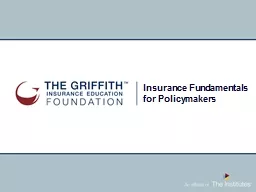

for Policymakers Four assignments Insurance Principles Insurance Coverages Property and Casualty Insurance Coverages Life and Health Insurance Regulation and Legislation Insurance Fundamentals for Policymakers ID: 319850
Download Presentation The PPT/PDF document "Insurance Fundamentals" is the property of its rightful owner. Permission is granted to download and print the materials on this web site for personal, non-commercial use only, and to display it on your personal computer provided you do not modify the materials and that you retain all copyright notices contained in the materials. By downloading content from our website, you accept the terms of this agreement.
Slide1
Insurance Fundamentals
for PolicymakersSlide2
Four assignments:
Insurance PrinciplesInsurance Coverages: Property and CasualtyInsurance Coverages: Life and HealthInsurance Regulation and Legislation
Insurance Fundamentals for PolicymakersSlide3
Insurance Regulation and the Role of the NAIC
Activities of Insurance RegulatorsState Government Insurance ProgramsMarket Conduct and Solvency RegulationInsurance Rate and Form RegulationInsurer LicensingIssues Around Insurance Fraud
Insurance Regulation and Legislation TopicsSlide4
States
regulate insurer formation, financing, investment, and taxation. They also regulate insurance rates, producer licensing, and marketing and claims practices.
Insurance Regulation and the Role of the NAICSlide5
The National Association of Insurance Commissioners
Encourages states’ cooperationDrafts model laws and regulationsHas no direct regulatory authority
The Role of the NAICSlide6
State
insurance departments enforce laws passed by regulators.
Activities of Insurance RegulatorsSlide7
Approve policy forms
Review rate filings and hold hearings License new insurersLicense some insurance professionals Investigate policyholder complaintsRehabilitate or liquidate insolvent insurersInsurance
Department
ActivitiesSlide8
Issue cease-and-desist orders
Audit insurers Evaluate solvency informationPerform market-conduct examinationsPublish consumer information Insurance Department ActivitiesSlide9
In some states, title may be insurance superintendent or director.
Depending on state, they may be appointed by governor or elected.Many have expertise and experience in insurance business.Insurance CommissionersSlide10
State
governments provide or operate insurance programs for public policy reasons.
State Government Insurance ProgramsSlide11
Workers compensation funds
Unemployment insuranceAutomobile insurance plansFair Access to Insurance Requirements (FAIR) plansBeachfront and windstorm poolsCommon State ProgramsSlide12
Monopolistic funds are the only source of coverage.
Competitive funds compete with private insurers.Residual market plans are for employers who cannot obtain voluntary coverage from insurers.Workers CompensationSlide13
Not available from private insurers.
Benefits vary by state. Minimum federal standards apply.Unemployment InsuranceSlide14
Cover those who cannot get auto liability coverage from private insurers (the residual market).
Costs spread among insurers.Typically administered by private insurers.Automobile Insurance PlansSlide15
Property insurance unavailable in private market.
Costs spread among property insurers.Cover exposures over which property owners have no control.Examples: urban riots, brush fires.FAIR PlansSlide16
Insure property against wind damage caused by hurricanes.
Available in hurricane-prone areas.Some states provide coverage through FAIR plans.Beachfront and Windstorm PlansSlide17
Pay claims of insolvent insurers
Funded by assessments against private insurersGuarantee FundsSlide18
To
protect policyholders and the public, states regulate how insurers conduct business and monitor their financial strength.Market Conduct and Solvency RegulationSlide19
Most states have unfair trade practices laws that apply to insurer:
SalesUnderwriting Claims handlingMarket ConductSlide20
Penalties for unfair trade practices
Agents/brokers—license suspension or revocationInsurers—fines; license suspension or revocationMarket Conduct—Sales and UnderwritingSlide21
Insurers and claim representatives can be fined for
Offering unfairly low settlements Failing to explain claim denialsMisrepresenting policy provisionsUnreasonably delaying claims resolutionMarket Conduct—ClaimsSlide22
The insurer’s ability to meet financial obligations as they become due
Includes obligations that might be claimed several years in the future Insurer SolvencySlide23
To verify solvency, regulators:
Set financial requirementsConduct field examinationsReview financial requirementsAdminister IRISSolvency SurveillanceSlide24
Minimum requirements to maintain solvency
Apply to all similarly licensed insuredsVary by stateFinancial RequirementsSlide25
On-site review of insurer activities
Every three to five yearsFocus on financial recordsField ExaminationsSlide26
Submitted to state insurance departments
Follow prescribed NAIC formatInclude data on premiums, expenses, investments, losses, and reservesIndicate insurers’ financial strengthAnnual StatementsSlide27
Early warning system
Applies ratios to financial statement data to assess financial conditionHelps identify insurers with potential financial problemsDesigned by the NAICAdministered by regulatorsIRISSlide28
If an insurer is determined to be insolvent, state regulators may:
Place it in receivership for rehabilitationPartially or completely take over its operationDissolve it and assign policies to another insurerDealing With InsolvencySlide29
States
regulate insurance rates and policy forms because insurance consumers need to be able to afford insurance and to understand the policies they purchase
Insurance Rate and Form RegulationSlide30
To be approved by regulators, insurance rates must be:
AdequateNot excessive Not unfairly discriminatoryRate RegulationSlide31
Mandatory
Prior approvalFile and useUse and fileFlex ratingOpen competitionTypes of Rate RegulationSlide32
Policy-form review
To ensure that policies are clear and readableTo detect unfair or unreasonable provisionsForm RegulationSlide33
Some states control policy content and structure:
Specific provisionsReadability standardsForm Regulation: ContentSlide34
Surplus lines insurers
Coverages for unique or hard-to-place risksCommercial coverages for large, sophisticated purchasersRegulatory ExemptionsSlide35
States
require that insurance companies be licensed. Most states also require that certain individual insurance professionals, such as producers and claim representatives, be licensed.
Insurer LicensingSlide36
Domestic
ForeignAlienInsurer Licensing StatusSlide37
Forms of OwnershipSlide38
Admitted insurers—licensed in state
Nonadmitted insurer—not licensed in stateAdmitted and Nonadmitted InsurersSlide39
Surplus lines laws permit
nonadmitted insurers to operate in a state.Restricted to selling insurance not available in admitted marketMust do business only through licensed surplus lines producerSurplus Lines InsuranceSlide40
States require licensing of some insurance workers.
Examples: agents, brokers, claim representatives. Must pass an examination.Continuing education required for renewal.Licensing of Individuals Slide41
The
billions of dollars insurers pay out annually for fraudulent claims are reflected in higher insurance premiums for all policyholders.
Issues Around Insurance FraudSlide42
Costliest white collar crime, next to tax evasion
10 percent of property-casualty insurance losses and loss expenses$32 billion per year (property-casualty)$400-$700 higher annual premiums per householdCosts of Insurance FraudSlide43
False claims
Exaggerated claims (padding)False statements on insurance applications (rate evasion)Types of Insurance FraudSlide44
Insurance Fraud: AttitudesSlide45
Respondents Who View Padding as Acceptable to Cover Premiums, by Age and
SexInsurance Fraud: AttitudesSlide46
Violent Crime Control and Law Enforcement Act of 1994
Federal Mail Fraud Statute Racketeer Influenced and Corrupt Organization Act (RICO) Federal Fraud LawsSlide47
Reporting statutes
Immunity statutesState Fraud Laws Slide48
States regulate insurance
RatesPolicy formsMarket conductSolvency
Professional licensing
Insurer licensing
Both federal and state laws apply to insurance fraud.
Summary